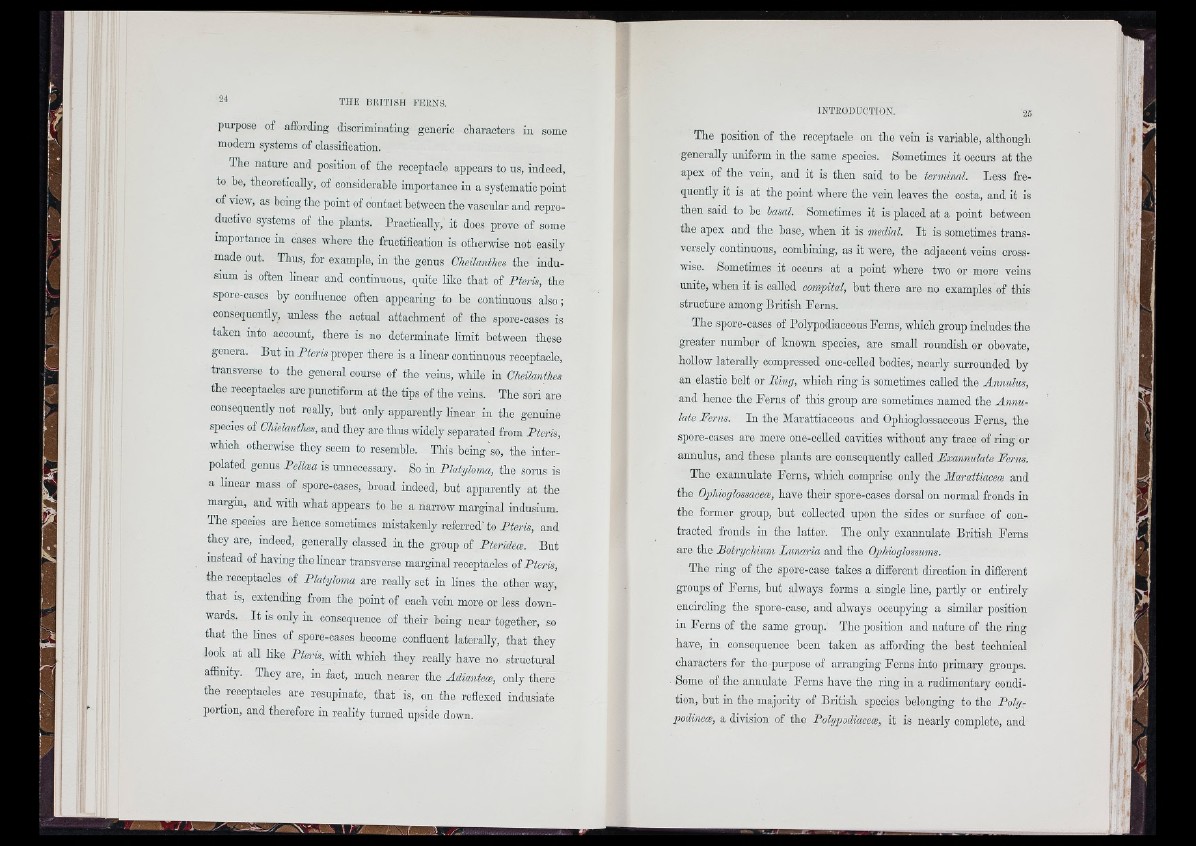
purpose of affording discriminating generic characters in some
modern systems of classification.
Tho nature and position of the receptacle appears to us, indeed,
to bo, theoretically, of considerable importance in a systematic point
of view, as being the point of contact between the vascular and reproductive
systems of tho plants. Practically, it does prove of some
importance in cases where the fructification is otherwise not easfiy
made out. Thus, for example, in the genus Cheilantlm the indusium
IS often linear and continuous, quite like that of Pteris, the
spore-cases by confluence often appearing to be continuous also;
consequently, unless the actual attachment of tho spore-cases is
taken into account, there is no determinate limit between these
genera. But in Pteris proper there is a linear continuous reooptaclo,
transverse to the general coiarso of the veins, while in Cheilanthes
the receptacles are punotiform at the tips of the veins. The sori aro
consequently not reaUy, but only apparently linear in the genuine
species of Chielcmthes, and they are thus ividely separated from Pteris,
which otherwise they seem to resemble. This being so, tho interpolated
genus Pellwa is unnecessary. So in Platyloma, the sorus is
a linear mass of spore-cascs, broad indeed, but apparently at the
margin, and with what appears to be a narrow marginal indusium.
The species are hence sometimes mistakenly referred'to Pteris, and
they aro, indeed, generally classed in the group of Pteridem. But
instead of having the linear transverse marginal receptacles of P^em,
the receptacles of Platyloma are reaUy set in lines the other way,
that is, extending from the point of each vein more or less downwards.
I t is only in oonsoquenoo of their being near together, so
that the lines of spore-cases become confluent laterally, that they
look at all like Pteris, with which they really have no structural
affinity. They are, in fact, much nearer the Adiantece, only there
the receptacles are resupinate, that is, on the reflexed indusiate
portion, and therefore in reality turned upside down.
• J . i .
The position of the receptacle on the vein is variable, although
generally uniform in the same species. Sometimes it occurs at the
apex of the vein, and it is then said to he terminal. Less frequently
it is at the point whore the vein loaves the costa, and it is
then said to bo lasal. Sometimes it is placed at a point between
the apex and the base, when it is medial. I t is sometimes transversely
continuous, combining, as it were, the adjacent veins crosswise.
Sometimes it occurs at a point where two or more veins
unite, when it is called compital, but there are no examples of this
structure among British Ferns.
The spore-cases of Polypodiaoeous Ferns, which group includes the
greater number of known species, are small roundish or obovate,
hollow laterally compressed one-oelled bodies, nearly surrounded hy
an elastic bolt or Ping, which ring is sometimes called the Annulus,
and hence the Ferns of this group are sometimes named the Annulate
Ferns. In the Marattiaceous and Ophioglossaceous Ferns, the
spore-cascs aro mere one-oellod cavities without any trace of ring or
annulus, and these plants are consequently called Exannulate Ferns.
The exannulate Ferns, which comprise only the Marattiacece and
the Ophioglossaeem, have their spore-cases dorsal on normal fronds in
the former group, but collected upon the sides or surface of contracted
fronds in the latter. The only exannulate British Ferns
aro the Botrychium Jjunaria and the Ophioglossums.
The ring of the spore-case takes a different direction in different
groups of Ferns, but always forms a single line, partly or entirely
encircling the spore-case, and always oooupjdng a similar position
in Ferns of the same group. The position and nature of the ring
have, in consequence boon taken as affording the best technical
characters for tho purpose of arranging Ferns into primary groups.
Some of the annulate Forns have the ring in a rudimentary condition,
but in the majority of British species belonging to the Poly-
podinece, a division of tho Polypodiaeece, it is nearly complete, and